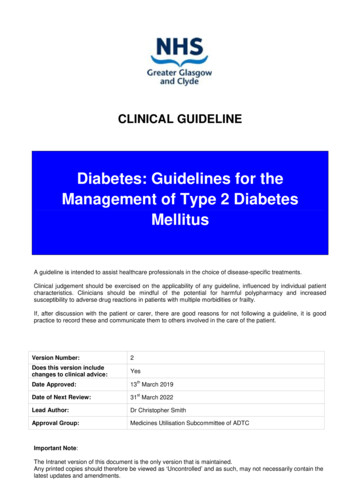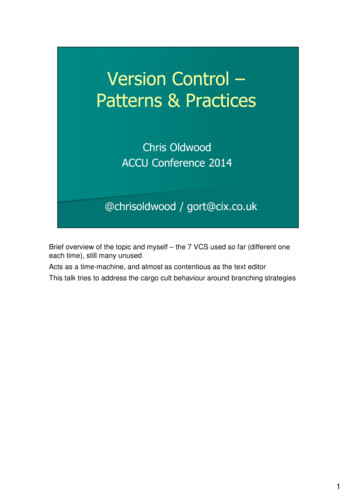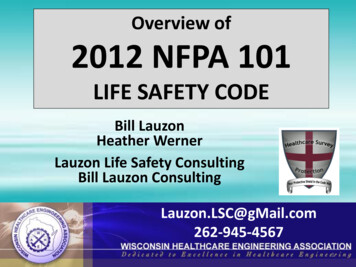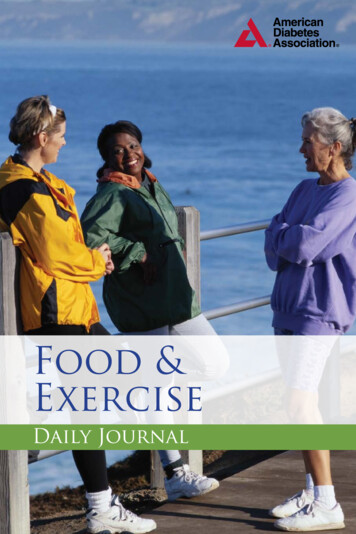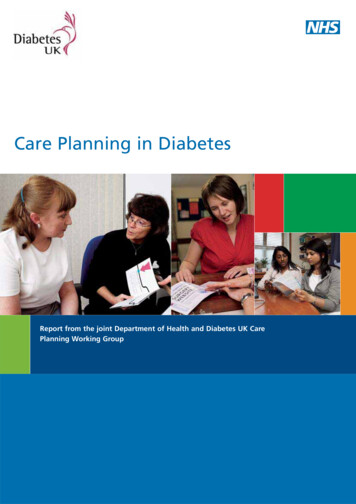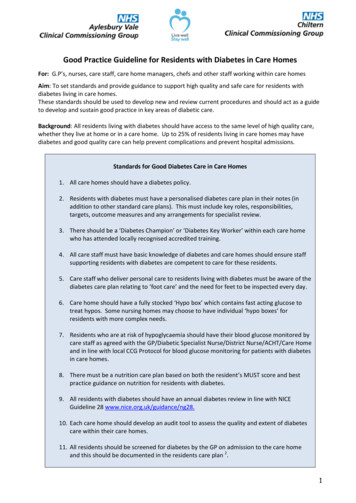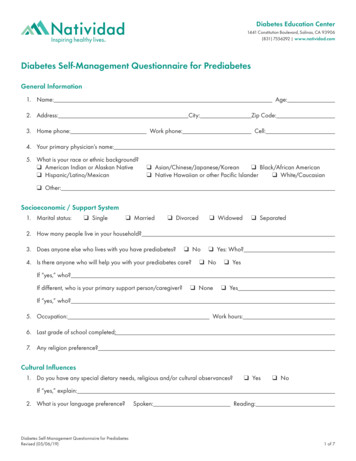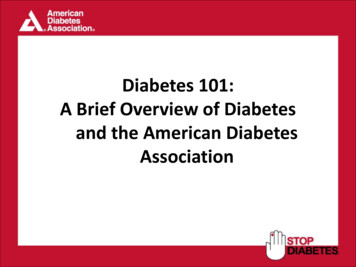
Transcription
Diabetes 101:A Brief Overview of Diabetesand the American DiabetesAssociation
What Happens When We Eat?After eating, most food is turned into glucose,the body’s main source of energy.
Normal Blood Glucose ControlIn people without diabetes,glucose stays in a healthy range becauseInsulin isreleased atthe righttimes and inthe rightamountsInsulin helpsglucose entercells
High Blood Glucose (Hyperglycemia)In diabetes, blood glucose builds upfor several possible reasons Liver releasesToo littletoo muchinsulin isglucosemadeCells can’t useinsulin well
Symptoms of Hyperglycemia Increased thirst Increased urination Blurry vision Feeling tired Slow healing of cuts or wounds More frequent infections Weight loss Nausea and vomiting
Hyperglycemia Can CauseSerious Long-Term ProblemsChronic complications of diabetes Blindness Kidney disease Nerve damage Amputation Heart attack Stroke
Two Main Types of DiabetesType 1 diabetesPancreas makes too little or no insulinType 2 diabetes Cells do not use insulin well (insulin resistance) Ability for pancreas to make insulin decreases over time
Type 1 Diabetes 1 in 20 people withdiabetes have type 1 Most people are underage 20 when diagnosed Body can no longer makeinsulin Insulin is always neededfor treatment
Symptoms of Type 1 DiabetesSymptoms usually start suddenly Weight loss Loss of energy Increased thirst Frequent urination Diabetic ketoacidosis(emergency conditionofnausea, vomiting, dehydration.Can lead to coma)
Managing Type 1 Diabetes Blood glucose monitoring Education Healthy food choices Physical activity Insulin
Before and After Insulin TreatmentDiscovery ofinsulin in 1921changed type 1from a deathsentence to achronic disease7-year-old childbefore and 3months afterinsulin therapy
Type 2 Diabetes Most people with diabetes havetype 2 Most people are over age 40 whendiagnosed, but type 2 is becomingmore common younger adults,children and teens Type 2 is more likely in peoplewho: Are overweight Are non-Caucasian Have a family history of type 2
Symptoms of Type 2 Diabetes Usually subtle or no symptoms inearly stages: Increased thirst Increased urination Feeling tired Blurred vision More frequent infections Symptoms may be mistaken forother situations or problems 1 in 4 with type 2 aren’t awarethey have it
Treatment for Type 2 Diabetes May ChangeOver a LifetimeAlways Includes: Education Healthy eating Blood glucose monitoring Physical ActivityMay Include: Medications,including insulin
Risk Factors for Type 2 Diabetes Being overweight Sedentary lifestyle Family history of diabetes History of gestationaldiabetes Age Ethnic/racial background: African American Hispanic/Latino Native American Asian American
Obesity Prevalence in Adults1994No Data20102000 14.0%14.0-17.9%18.0-21.9%22.0-25.9% 26.0%Diabetes Prevalence in Adults1994No DataSource: CDC20102000 4.5%4.5-5.9%6.0-7.4%7.5-8.9% 9.0%
Diabetes in the United States More than 29 million people in the U.S. have diabetes 8.1 million people with diabetes are undiagnosed 9.3% of the U.S. population 1.7 million Americans aged 20 years or older were newlydiagnosed with diabetes in 2010 Every 19 seconds, someone is diagnosed with diabetesSource: National Diabetes Fact Sheet, 2014
Burden of Diabetes in the United States The leading cause of: new blindness among adults kidney failure non-traumatic lower-limb amputations Increases the risk of heart attack and stroke by 2-4 fold 7th leading cause of death Mortality rates 2-4 times greater than non-diabetic people of thesame ageSource: Centers for Disease Control and Prevention
Burden of Diabetes in the United States Total direct and indirect cost of diagnosed diabetes is 245 billion ayear Total diabetes-related costs are more when you add gestationaldiabetes, prediabetes, and undiagnosed diabetes 1 in 5 health care dollars is spent caring for someone withdiagnosed diabetes 1 in 10 health care dollars is attributed directly to diabetes
What is Prediabetes? 1 in 3 American adults(86 million) have prediabetes Occurs before type 2diabetes Blood glucose levels arehigher than normal but notyet diabetes Most people withprediabetes don’t know theyhave it
Is There Any Good News? Yes, we can reduce the chances of developing type 2 diabetes inhigh-risk people (weight loss, exercise, medications) Yes, we can reduce the chances of developing diabetescomplications through: Blood glucose control (diet, monitoring, medication) Blood pressure control Cholesterol control Regular visits to healthcare providers Early detection and treatment of complications
Preventive Efforts Are Key Most of the diabetes costs are dueto end-stage complications Investment of resources into earlydiagnosis, patient education,prevention and treatments pays offin: Longer lives Increased productivity Reduced costs over the longterm
Steps to Lower Your Risk of DiabetesComplications A1C 7 Blood pressure 140/90 Cholesterol management with lifestyle changes andmedicine Get help to quit smoking Be active Make healthy food choices Take care of your feet Get recommended screenings and early treatment forcomplications
The American Diabetes Association:What We Do - Research In 2014, the Association madenearly 30 million available tosupport diabetes research Over the years, the Association hasinvested more than 700 million inmore than 4,500 research projects
The American Diabetes Association:What We Do - Education Center for Information andCommunity Support communicatesthrough phone, email and chats Health fairs, programs, camps andother events target millions of peoplearound the country Award-winning books and DiabetesForecast magazine for consumers Journals, books, and clinicalguidelines for health careprofessionals Scientific Sessions: Largest diabetesmeeting in the world
The American Diabetes Association:What We Do - Advocacy Seek increased federal and statefunding for diabetes prevention,treatment and research Promote public policies to preventdiabetes Advocate to improve theavailability of accessible, adequateand affordable health care Fight discrimination people withdiabetes face at school, work, andelsewhere in their lives.
More Information 1-800-DIABETES askADA@diabetes.org Social media information: www.Facebook.com/AmericanDiabetesAssociation @AmDiabetesAssn www.diabetesstopshere.org Web: www.diabetes.org www.stopdiabetes.com
Yes, we can reduce the chances of developing type 2 diabetes in high-risk people (weight loss, exercise, medications) Yes, we can reduce the chances of developing diabetes complications through: Blood glucose control (diet, monitoring, medication) Blood pressure control Ch
